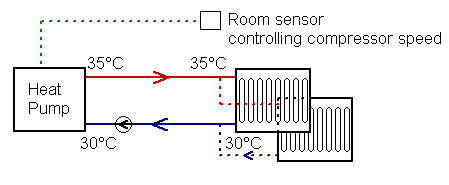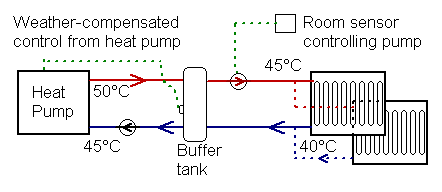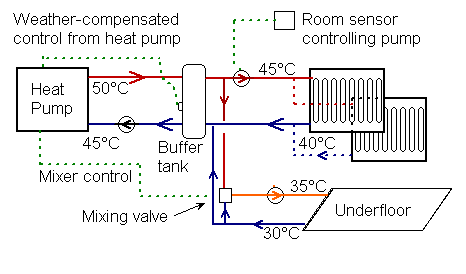These blogs are usually triggered when I come across issues (several times) that bother me… here goes.
Theory and practice show that the best performance for any (1) heat pump is achieved if the average water temperature that the heat pump ‘sees’ (the water temperature passing through it) is kept low (2), whilst still achieving the required level of comfort.
It is all very well installing underfloor heating or radiators that can give high heat-outputs with low circulating water temperatures. However, the actual temperatures may deviate significantly from the theoretical, and this is highly dependent on the control system provided. It is often assumed (by both installers and users) that the controls are capable of doing what you need… not always the case.
Whilst the SCOP rating and the predicted flow/return temperatures would seem to have the greatest bearing on energy-efficiency, it really hangs in how well it is controlled.
I am hopeful that over this decade we will see far better control systems. It strikes me that we are in a ‘middle’ phase with some claims of ‘intelligent’ control, but actually its not always helpful in practice. Furthermore, many programmers and controls are still user-unfriendly. No wonder that many are not programmed as they should be.
Whilst things have got better, I still come across installations that are clearly not ideal. E.g. inadequate controls, or sometimes too many and too complicated. It is often very hard to estimate how worthwhile (cost-effective) any modifications would be. This would ideally involve some performance monitoring over time. So, annoyingly, many systems remain in a non-ideal state.
I don’t want to worry people unnecessarily here. Most installers know what they are doing! Many systems are well optimised, and do just what they say on the tin, but people still need to be mindful that it’s not always the case.
The below are some typical general examples, but there are many other offerings and options out there.
Some typical control methods
When things are simple, there are fewer potential pitfalls

Here we have an as-simple-as-it-gets system. In this case the room control is the ‘target temperature’ or ‘auto adapt’ type. This modulates (variable inverter) the flow temperature according to room temperature so the actual water temperatures can adjust itself from anything below 30°C to above 40°C depending on the demand. The average water temperature over the year can be surprisingly low, giving low running costs. In this case, the Room control is supplied with the heat pump.
This is a good system for open-plan houses, and extremely well-insulated houses, but when we get into larger houses with different rooms used at different times, and radiators upstairs with underfloor downstairs, we can start running into trouble…. To be clear… It will heat adequately, but the running costs could become higher than they should.
The next level of complexity may involve a buffer cylinder. This is simply a tank of water. It might store something in the order of up to 20 minutes worth of heat. It is generally needed in buildings where there are many zones (many rooms), and where you may at times want only one zone on.
The simple principle is this –
* The heat pump heats the buffer cylinder to a certain temperature (variable over the year).
* Heat is pumped from this cylinder to rooms as required.

Unlike the first example where the controller ‘learns’ the lowest (and most efficient) water temperature possible, in the buffer tank case, a pre-determined temperature has to be set, and this usually uses a ‘weather compensation curve’ (put simply 50°C when very cold out, 30°C when mild, and a sliding scale between the two).
The ‘curve’ setting is usually found by trial and error, but as I am all too often finding, this is often set higher than it actually needs to be. E.g. in my example it is heated to 50°C. Water at the radiator may (due to mixing) be at 45°C, and the thermostat in the room will ‘cycle’ the pump with on and off periods. The radiator at a constant 35°C might suffice.
Compared to our first example, the heat pump ‘sees’ water at a considerably higher temperature, so the average COP is worse.
Ideally, the set point of the buffer would not only depend on the outside temperature, but it could reduce for certain periods of the day, and also reduce depending on the house temperature. Many manufacturers have a facility for this, but I very rarely see it being used well. Some controls allow two curve settings over the 24hr period. Most don’t.
Underfloor and radiators on the same system
A next level of complexity is where mixing valves are used. This is typical when both underfloor and radiators are used on one heat pump.

Here we can see an underfloor circuit that only needs water at the lukewarm temperature of 35°C. Whilst our heat pump would heat this very efficiently, unfortunately the system takes all water up to 50° (less efficiently), only to mix some of it down to 35°C. If our control was ‘cleverer’, it could drop the buffer set temperature for certain periods of time when only the floor needs heating. However, few currently available controls will cater for this.
These examples are only a few of many options and combinations. Of course, the manufacturers have thought this all through, however, it would be impractical to make controls for every circumstance.. it could be too complicated, so they tend to evolve a ‘system’ and hope it will suit most applications.
Intermittent and continuous heating
For houses that are unoccupied during the day, or offices that are vacated evening and night, there is no point keeping them warm all the time. That said, if the heating is completely off for too many hours, then the required catch-up (heat-up) may be difficult for our heat pump. In practice, a compromise is usually sought, with ‘occupied’ and ‘unoccupied’ temperatures. This is of course dependent on the building, be it insulated or not, heavy stone or lightweight etc.
For constantly-heated homes, heat pump installations can be simpler. But for intermittent heating, some extra complexity and extra capacity may be needed.
That said, for most of the year, there is spare capacity, so it may be perfectly acceptable in many situations to forego intermittency during the relatively brief coldest periods of the year. Again, good controls would be key to optimising this. In the meantime, owners can set controls the best they can, but my feeling is that because programmers and controllers can be quite a chore to set correctly, many are not set well.
There seems still to be a lot to learn about the best way to operate heat pumps in different buildings with different situations, with respect to intermittency or constant.
A final gripe, .. for anyone trying to set a digital room thermostat to a frugal setting. This could be in a workroom of maybe a big lofty room in an old house. The ‘jump’ between settings of 16°, 17° or 18°C is great. If energy-use is a minor issue, then you simply go 1° higher, but if you are keeping a tight rein on cost (e.g. a village hall), a finer control is desirable. Manufacturers… please allow ½°C adjustment increments. (It seems that 1°F increments are however about right). Gripe over.
Footnotes
- (1) The exception here could be a ‘transcritical’ heat pump using Refrigerant R744 CO2. These produce very hot water with relative efficiency, but don’t generally achieve the high COPs at low temperatures that other conventional types can.
- (2) How low can you go and still get an increase in COP? Whilst graphs show a trend of increased COP down to say 30°C, what happens below this? I have done various ad-hoc test to the best I can, and found that some older fixed-speed designs tend to flatten off around 25-30°C. But I have been surprised how efficient some inverter units work. This is could be to do with two things. i) better refrigerant control with an electronic expansion valve and ii) better motor power at very light loading.
We have installed a 11.6 kW air source which is configured as a hybrid / bivalent system, alongside a conventional oil boiler. I’ve noticed that the heatpump consumes around 380 watts / day, when not in use. Whilst not excessive, this will cost around £50 pa when the new energy cap arrives in October. You say that you isolate your pump in warm weather, but my installer says this is not practical. It must be possible to install a cut out switch on the power circuit?
Similarly, when the central heating switches from the heat pump to the oil boiler in colder conditions, the heat pump is still engaged. Not only is this a waste of electrical energy, I would have thought that the increased circulating temperature might damage the heat pump?
Finally, it seems odd that the automatic switchover from heat pump to oil boiler is set at an arbitrary 5.5 degrees external temperature. This is pre-programmed and I am unable to adjust it. My installers cannot give me an adequate explanation for this. I would have thought that the controls ought to be flexible enough for me to adjust the switch over temperature/
Any thoughts gratefully received
Hello Andrew
Well,.. 380kWh/day is average of 16 watts.. This is good for standby…. surprisingly low. But now, hopefully manufacturers have improved matters and any necessary compressor oil-warming is now done ‘only as required’ i.e. not 24/7 like it used to be!…. I dont know.
Over the year, that ‘standby’ is often necessary, since the system is ‘ready to go’, but as you point out, below 5.5 degrees, the heat pump is on ‘stop’ (is that right?), but it is exactly that time when the compressor might need keeping a bit warm (but there is a debate to had here).
I tend to feel that your 16 watts (If I have that right) is a small thing to worry about.
Re the 5.5 degrees. I am surprised that the controls are not more ‘intelligent’ than that. Yes, I agree, it is very crude. e.g. your system should fairly easily be able to ‘load sense’ and estimate the need to change to the boiler. The Germans and Swedes (and others) have for over 20 years been doing bivalent controls that only changed if the HP actually needed help. The Manufacturers need pushing to make these refinements. It will all come in time, but in my opinion, should be on all hybrid systems.
So, surely that arbitrary 5.5 was estimated, assuming a full house and fairly warm rooms. I would be very interested to know how low (outside temp.) the ASHP could manage. I guess you should be mindful that there could be something else unknown here.
Hello John,
Many thanks for your reply.
I’m very encouraged that you reckon the 380 watts / day (16 watts / hour is reasonable however, it does feel a bit of a waste over the +/- 6 months the heat pump isn’t in use, and also has an impact on the RHI calculations. I should have thought it would be sensible to have the option to turn off the entire system over the summer, as you suggested you do, in reply to James Peto.
I think the fixed 5.5 degrees point at which the oil boiler kicks in was a guestimate. We only heat 4 rooms during weekdays and the heat pump would probably be adequate at an even lower external temperature, but we are unable to experiment with this as we are unable to vary the temperature at which the system flips to the oil boiler. However, at weekends, when the family and grandchildren inevitably arrive, we have to heat the whole house, which means we resort to the oil boiler (a 29kW job). As I mentioned before, when the oil boiler is in use, the heat pump is still engaged, which I’m sure can’t be efficient and I worry that it might damage the heat pump.
Again, many thanks for your thoughts.
Best Regards – Andy Main
Oh… I made a typo.. Its 380Watt-hours/day, about 140kWh/year, or an average of 16 watts. I got this from your 380watts/day. I hope that is right. Its actually a small proportion of the total annual use.
I’m not exactly sure if your system switches to oil at 5.5 degrees, or if at 5.5, the oil boiler is enabled to be ready if needed. Its possible that your system does in some way ‘gauge’ if the heat pump needs help, so its possible that the boiler is held-off, even below 5.5 degrees, until needed. What model is it? Maybe you need to experiment one day when its cold. have most rooms off, and see if at say 4 degrees if the ASHP keeps going, and if the boiler fires
Hello John,
Sorry for tardy response, but we’ve been away!
The heat pump is a Midea MHC V12W monobloc. I’m heartened that the ‘standby’ electricity usage of 380 wats / day isn’t too high, although I might ask the installers to install a switch to enable me to turn it off completely over the summer months.
5.5 degrees is the programmed external temperature at which the oil boiler becomes engaged and I am not able to alter this, which is a bit frustrating, as I would like to determine how effective the heat pump is at lower temperatures. We also have a switch which allows the oil boiler to kick in (when we have the family and need to heat more rooms). There is no clever sensor whereby the system ‘gauges’ if the pump needs help.
The most annoying thing is that the heat pump continues to operate, while the oil pump is engaged – my worry being that this is wasted electrical energy and that it may damage the heat pump with the higher circulating temperature from the boiler.
Thanks again – Andy
Sorry for the delay.. this got overlooked.
I don’t know about your particular boiler hybrid control, but the outdoor temperature setting at which the boiler is ‘available’ will vary a lot site-to-site. It really depends on the HP sizing, and whilst some speak of ‘accurate sizing’, in reality there are only a few sizes of heat pump available, and inevitably some installs are a bit bigger than needed. So, I am surprised that the 5.5 isnt adjustable. Some systems (usually the better ones) will allow some overlap where the boiler ‘supports’ the running heat pump, so they both operate together. It all depends on the way the system is configured… re pipes and re controls.
We have a very well insulated house with 5 zone underfloor heating fed by a buffer tank heated by an Air Source Pump running only in the 7 hours of off-peak electricity. – after much energy monitoring it transpires that a large proportion of the running costs are caused by the electricity consumption of some 350 watts per hour on standby.
Do you consider that it would be a good idea to fit a timer to the electrical circuit to isolate the pump for 13 hours per day when not required?
350watts of standby sounds a heck of a lot. Firstly, are you measuring with a real-power device. Current-only sensors can overestimate standby considerably…. you may already know this. The ASHP unit, at rest, is unlikely to be taking anything like 350 watts. It is likely to have a small compressor oil-heater, this is needed, and the general advice is to leave the power on. Is much of the power going on other things? Are circulation pumps on when not needed? You should be able to turn these off. You could also review their energy use. Are the circ pumps ‘A’ rated low energy types? Anyhow, If you system is only needed for less than 1/2 the time, then the standby becomes very excessive. I certainly isolate my ASHP in warm weather. Turning back onto stand-by, several hours before it actually runs, is recommended
I agree totally and a lot of the controllers and very hard to set up let alone for the average joe